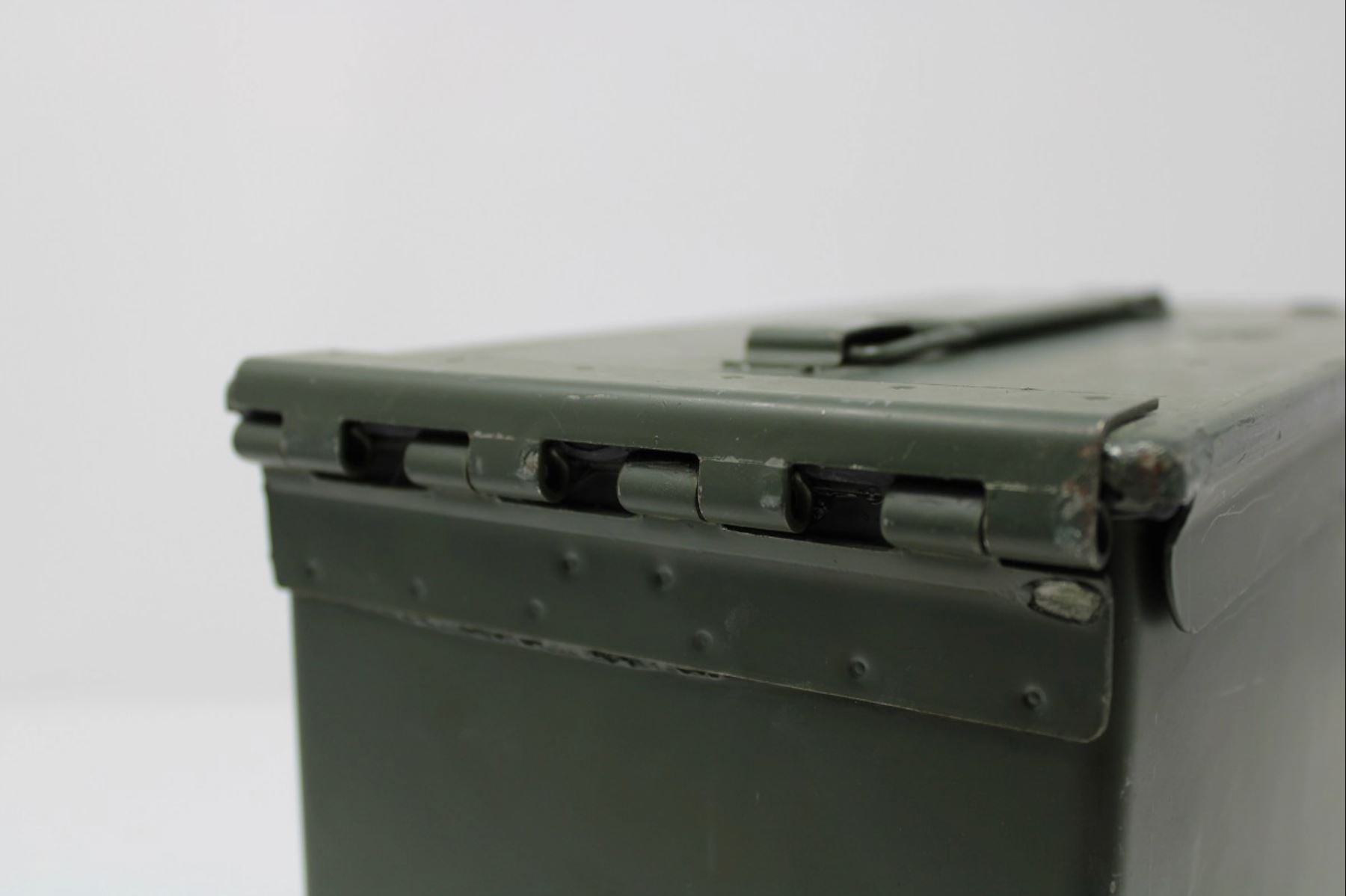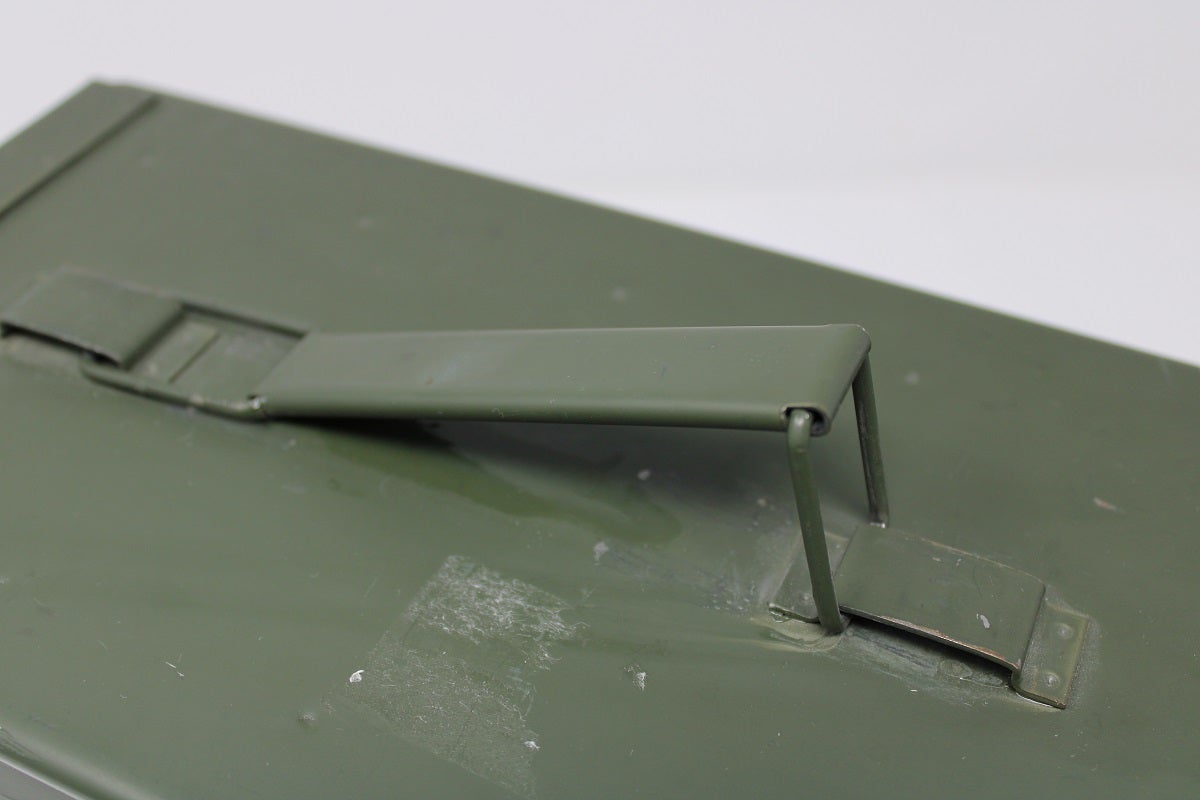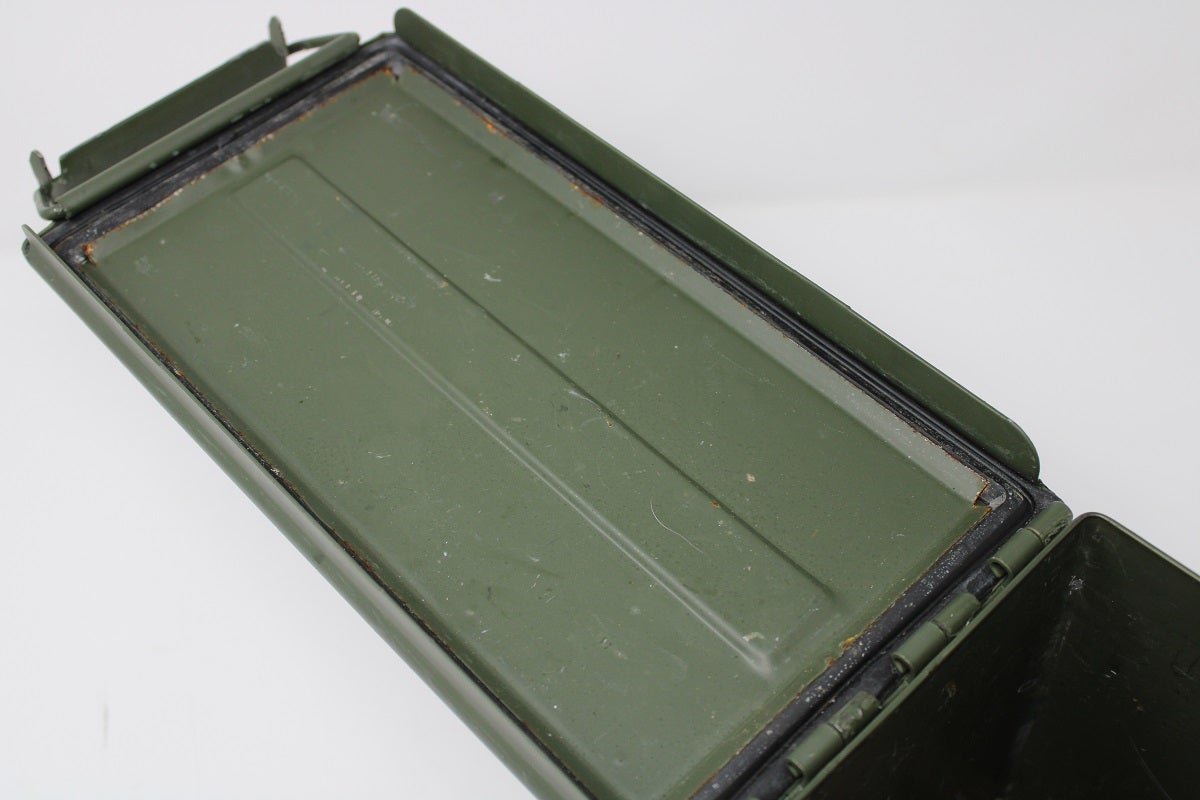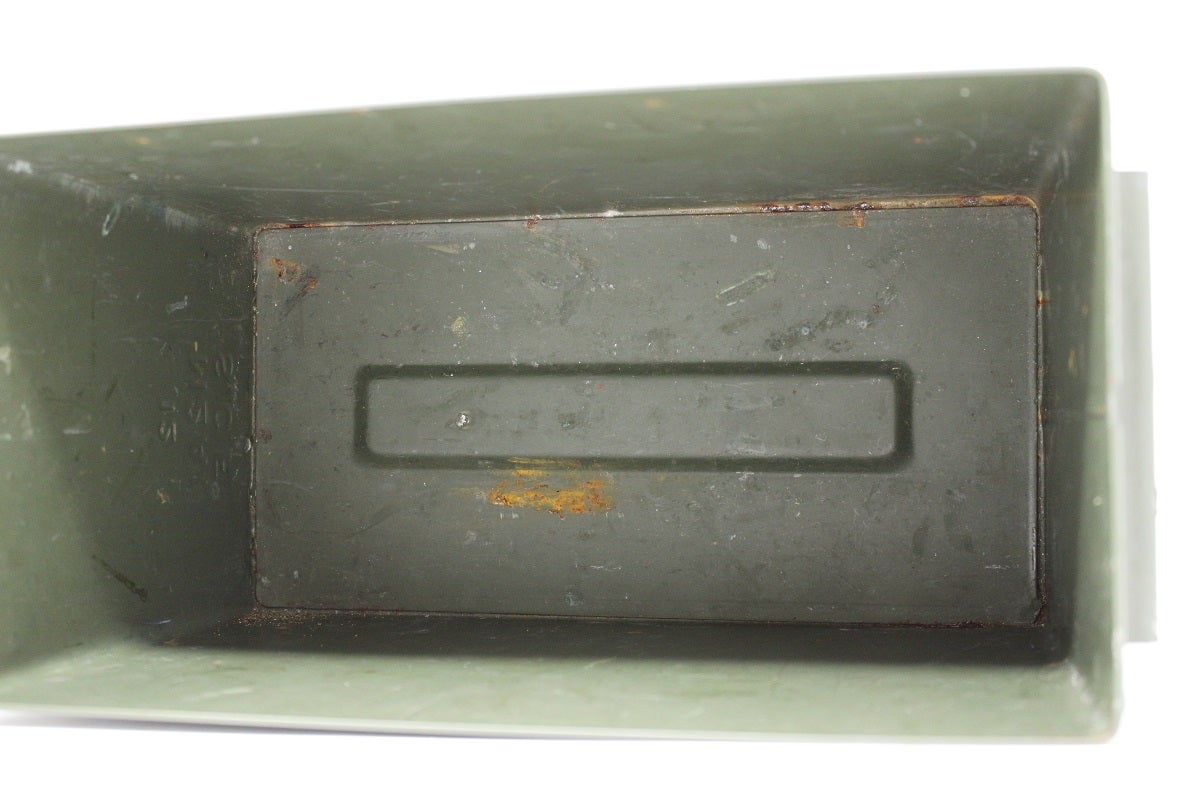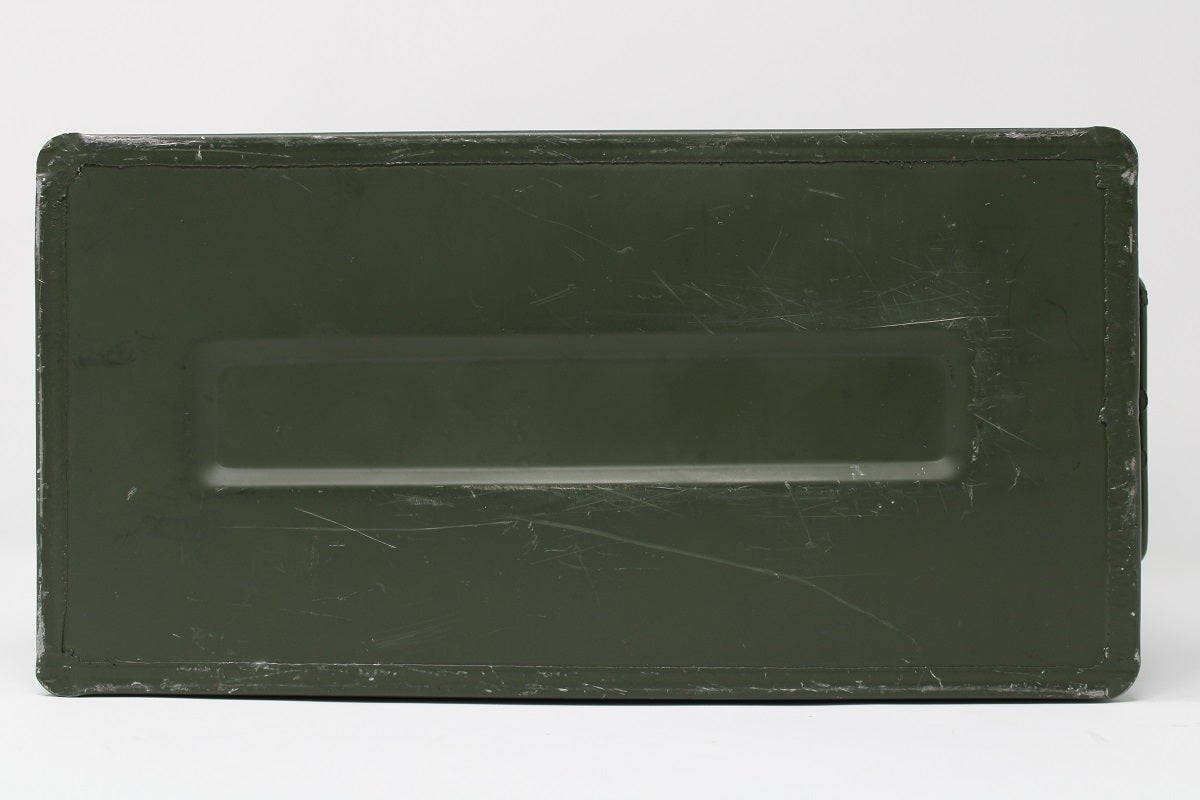Why the M2A1 is The Best Ammo Can, Ever
Travis Olander 03.15.23
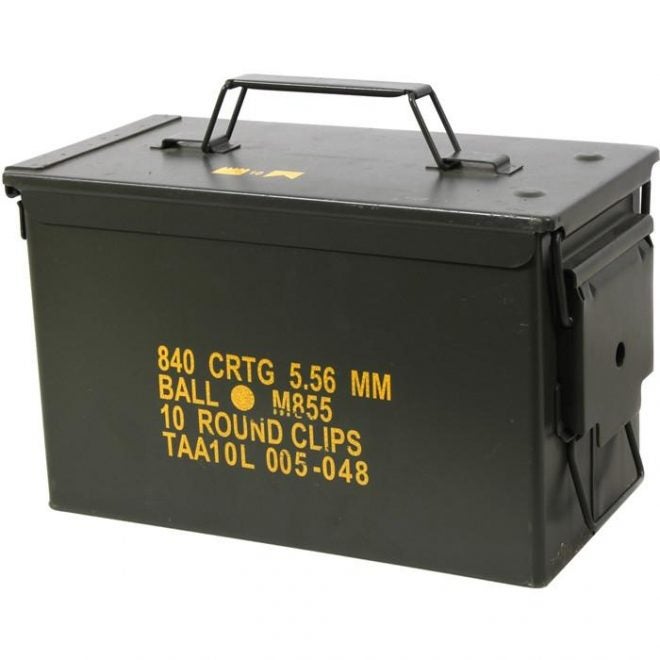
The steel M2 Ammunition Can was introduced to U.S military branches on the 21st of September, 1942. The M2 ammo can was designed to hold linked belts of .50 cal. ammo for the M2 Browning machinegun, but its large capacity and carry handle made it effective for storing other munitions and supplies. It was, however, found inadequate in cold- and wet-weather environments. So, in the 1950s, the M2 was replaced with the now-infamous M2A1, complete with weatherproof seals and a redesigned latch and lid made to handle more weight and stack easily. Some say the M2A1 ammo can ( a proper military surplus can, that is) represents perfection in small arms munition storage. It’s a perfectly round wheel that can’t be reinvented. Today, we’re breaking down why this old relic remains one of the best ammo cans you can buy and use today.
The M2A1 Can at a Glance
First off, the M2A1 is not your typical pretty, shiny ammo box. If you make the right move and buy a coupla’ these cans to store your munitions, they’ll might arrive with a bit of chipped paint, faded lettering, and plenty of dust. They’re coated with a very tough OD green paint that’s functional, but certainly not a looker. They’re almost always authentic Army surplus, meaning they’ve already handled hundreds of rounds of ammo, sat outside at a qualification range, or been kept in a Conex shipping container at 110 degrees. That’s not to say these steel cans aren’t capable of surviving all those conditions and a hundred years of the same, or more. They have, they do, and they will.
Main Specs / Features
- Pressed solid steel sides, lid, and bottom.
- Seam-welded to make one unibody box.
- Latch, hinge, handle also welded to body.
- End-opening lid with quick release hinge.
- Quick release latch with tight snap for handling high amounts of weight.
- Rubber gasket under lid makes can waterproof when latched is closed.
- Handle attached to lid by rectangular wire loops. Folds flat for stacking.
- Lid skirts protect contents when lid is partially opened.
- Cans are capable of holding at least 50 pounds each.
In-Depth Review
First, Pick a Size
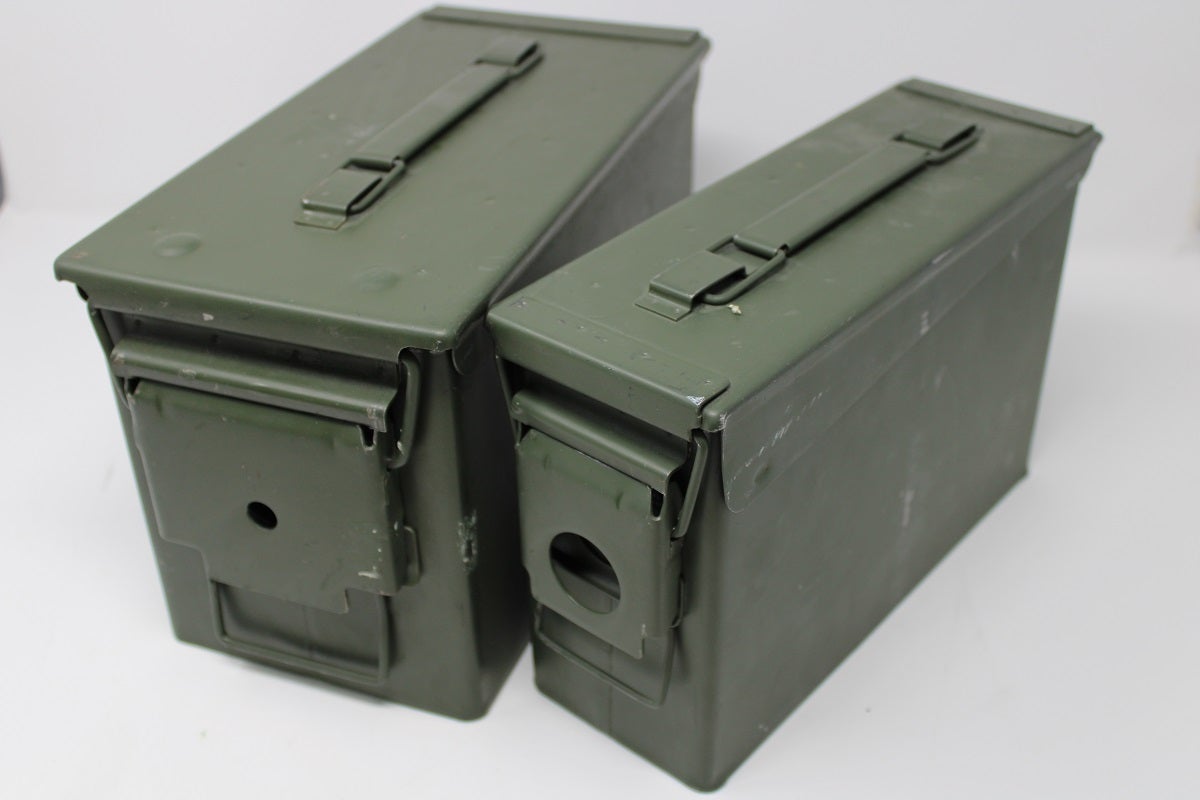
The M2A1 can is available in more than one size. The smaller variant (officially titled the M19A1) is typically used by the forces to store and carry the 5.56 and 7.62 NATO ammunition for small arms. These smaller cans are often simply called “.30-cal cans.” Each small can is capable of holding 200 cartridges of 7.62 NATO, and about 540 rounds of 5.56 NATO, commonly held in stripped clips for hand loading.
Importantly, both the M2A1 and M19A1 sport the same steel, latches and lids, seals, and painted finishes.
The Latch Assembly
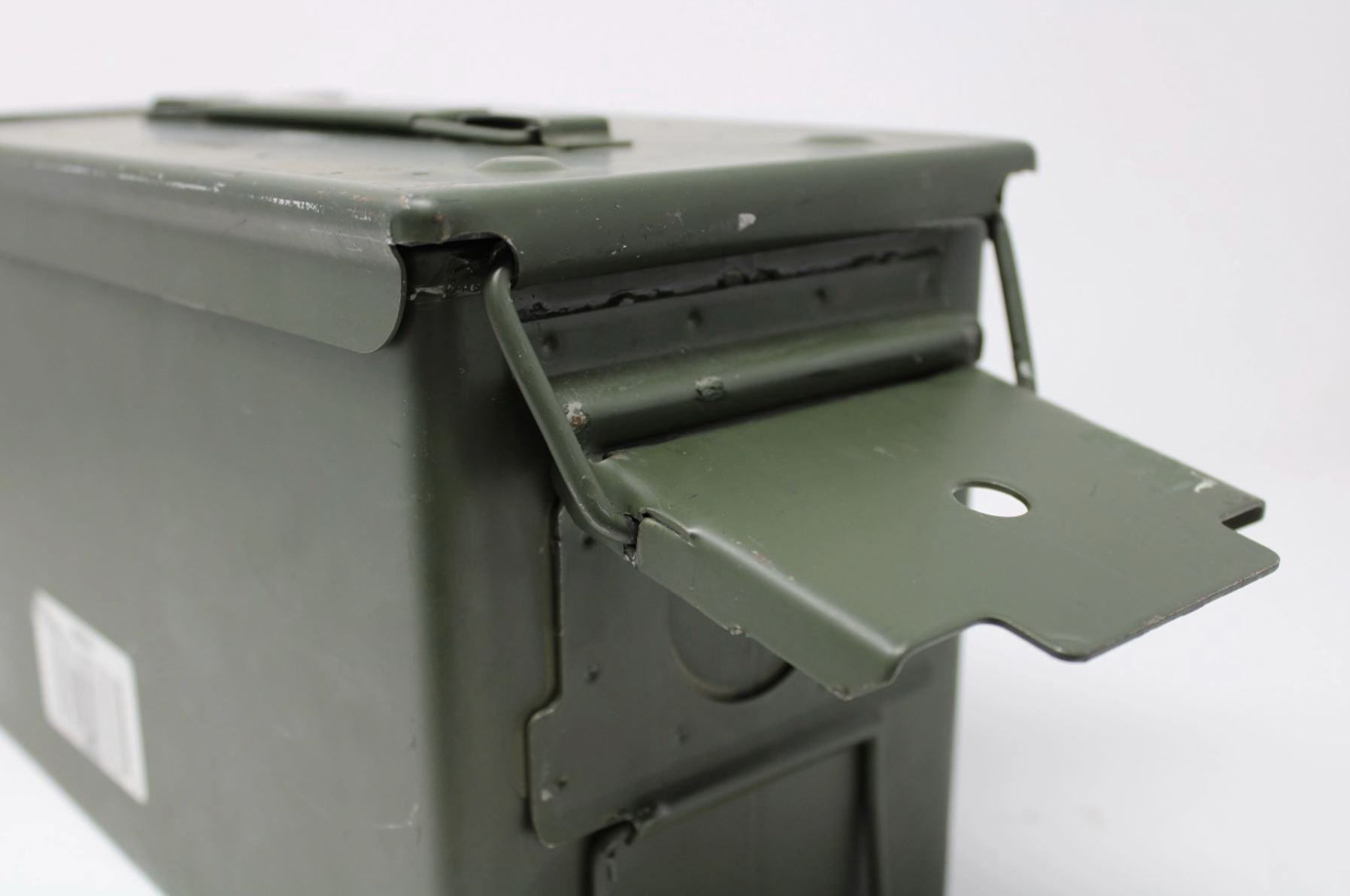
The latch makes the ammo box, and in this case, it makes one helluva container. With a bad latch, you’ve got a useless container that can’t handle weight, nor can it handle the elements. Thankfully, the M2A1 latch will probably break a finger (or at least a fingernail) if you’re not careful when snapping it shut. It’s a strong, tight, springy latch made from solid steel.
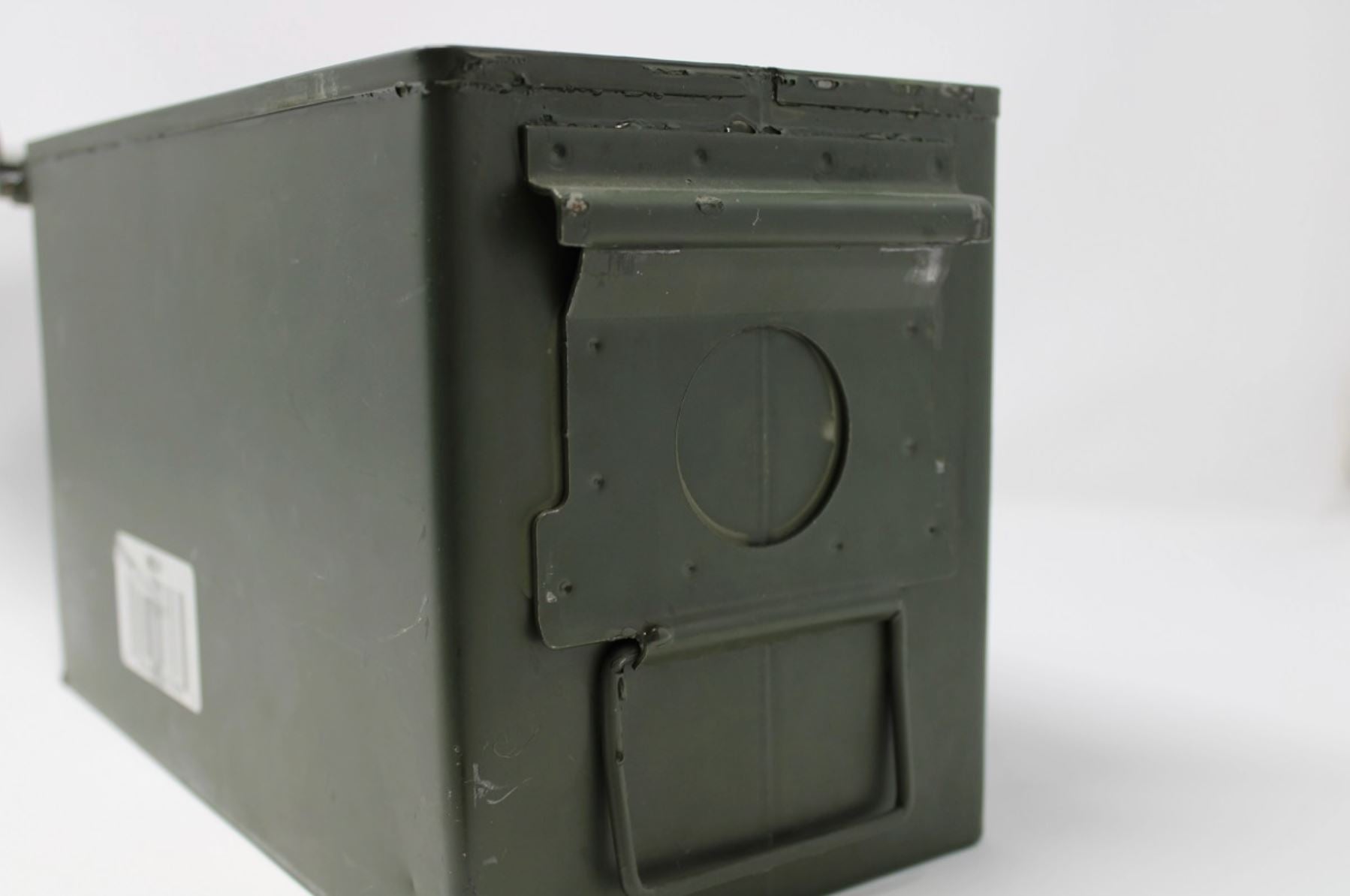
The latch itself uses high tension to keep the lid snapped shut. Considering this can is capable of holding 50 pounds, it needs a reinforced, tack-welded plate to keep an iron-tight hold on the box when the latch is engaged. The large latch paddle makes prying it open and close easy enough. Just mind your digits when you slam it home.
The Lid
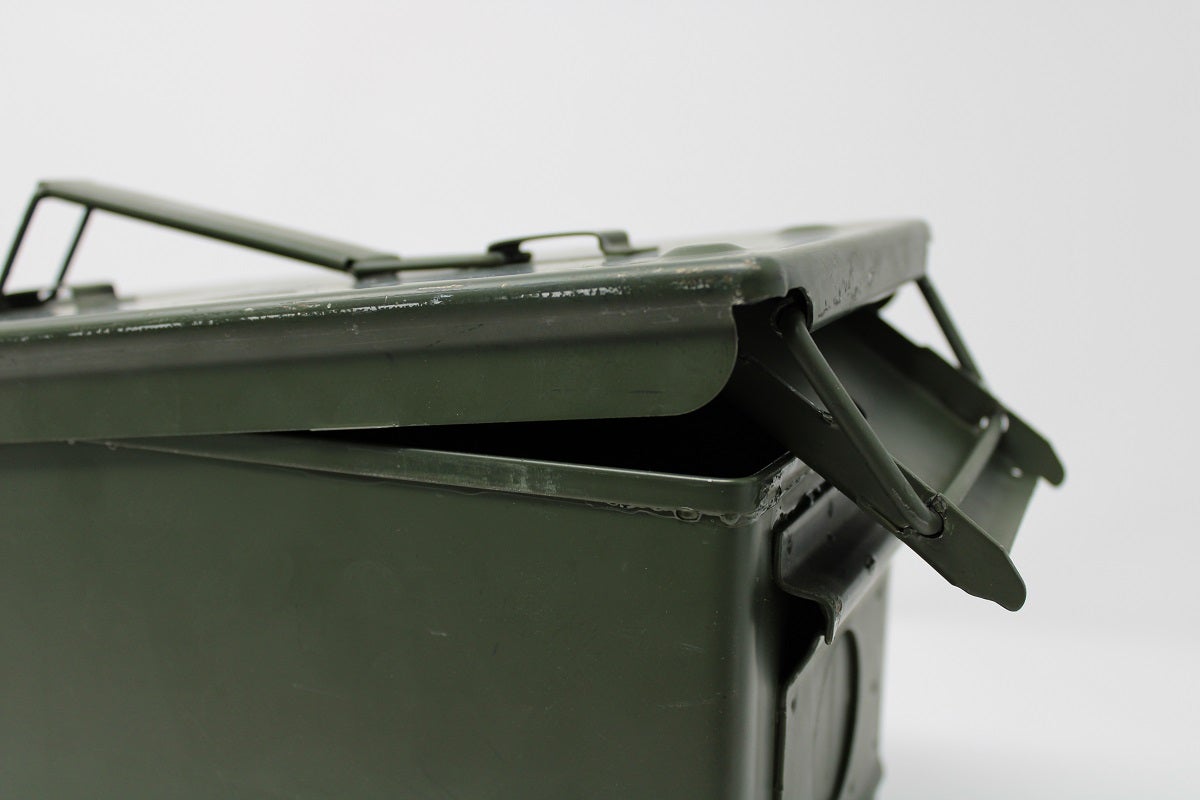
The lid is made from the same rolled steel as the rest of the container. It’s solid and capable of taking a fully stacked can above it without bowing or flexing. The sides of the lid sport a nice long skirt to protect against the elements and to help keep rain and water from getting inside, if you’re operating outdoors in a wet environment.
The Lid Pins
The lid would do no good if it weren’t fastened by some strong pins. Thankfully, it is. Four large steel pins, rolled inside the steel on both the lid and box, secure everything together. Like the hand latch’s mount, the pin mounts are welded to the lid and box to provide a solid, fastener-free connection.
The Handle
The lid on the M2A1 (and M19A1) is just as tough as the rest of the unit. It, too, is steel with rolled edges that are relatively comfortable to grasp. After all, you don’t want a flat steel edge digging into your fingers and palm when you’re lugging around 50 pounds’ worth of brass. The handle is secured with two metal clips that allows it to fold flat. The tabs securing the handle to the lid are also welded, eliminating the need for fasteners.
Weatherproof Seal
Although it doesn’t look like much, this black rubber gasket provides one of the most important features of the M2A1 (and M19A!) ammo cans: A solid, reliable anti-moisture and water barrier, making the can effectively weatherproof and moderately waterproof. Sure, you can dunk the can in a river and expect it to remain watertight, but it’ll handle just about any other wet environment. More importantly, this gasket helps with longterm storage. The military does, after all, leave millions of rounds of small arms munitions in damp bunkers for years (and sometimes decades) at a time.
These gaskets do the proper job of protecting ammo from corrosion during storage in less-than-ideal conditions. This is one of the reasons the M2A1 can is one of the best ammo containers you can buy: It’s properly “mil-spec.” It’s been tested to high standards to withstand the elements.
Interior Storage
If you were expecting some magic, here, you’ll be disappointed. The interior of the can is about as simple and utilitarian as the rest of the thing. No special storage compartments or foam. Just an empty steel box. You do, however, get a floor that is welded to the walls and properly sealed with an extra layer of steel on the outside, to protect against the seams and prevent the welds within from ever cracking or rusting through:
The indent in the center of the can is for stacking. This small recess allows the handle atop the lid the M2 can to rest completely flat underneath the floor of the container atop it.
So, why is the M2A1 the best ammo container?
There are quite a few reasons we believe the M2 and M19 cans are the best ammo containers, maybe ever:
Construction and mil-spec standards.
Unlike literally every other ammo container advertised on the civilian marketplace, the M2 and M19 cans undergo military “torture testing” and have to adhere to relatively strict performance standards under the MIL-DTL-3060F Specifications Document produced by the U.S. Army Armament, Research, Development and Engineering Center. That’s a mouthful.
To meet all the military’s requirements, these ammo containers have to undergo salt spray testing, water testing, and corrosion testing. Certain features of the box are purposefully overbuilt, too. The handle needs to withstand a pull force of 300 pounds for up to one minute. The latch and pins for the lid have to withstand a pull force of 1,000 pounds. Even the gasket and paint need to adhere to exacting measurements.
To put it plainly, no other ammo containers are currently on the market that provide this level of construction and performance, backed by stringent testing. At least not at this ammo can’s price point. Which brings us to the other main reason why the M2 and M19 are the best choices for ammo storage:
Cost and availability.
For all this mil-spec stuff, you’re still paying a fraction of the price that many modern, commercially available ammo cans command at market. You can grab a tried n’ true, U.S surplus M2A1 for about $22 bucks. They may come with a few scratches and scrapes, but they’re functionally perfect. Newer M19A1 cans can be had for about $25. If you do some digging at your local Army-Navy Surplus, or even just browse online auction sites like eBay and Gunbroker, you’re likely to find these cans on the cheap, too. Thanks to the U.S military producing these cans for decades, they’re some of the most readily available.
FAQ
Q: What are the interior dimensions for the M2A1 and M19A1 cans?
A: The M2A1’s interior dimensions are: 11.125″ long x 5.688″ wide x 6.813″ tall.
The M19A1’s interior dimensions are: 10.188″ long x 3.625″ wide x 6.688″ tall.
Q: What are the exterior dimensions for the M2A1 and M19A1 cans?
A: We’ve taken the exterior width and length measures using the lid, since it is slightly longer and wider than the rest of the container. The size of the lid should thus be considered when measuring storage space requirements.
- The M2A1’s exterior dimensions are: 11.75″ long x 6.00″ wide x 7.125″ tall.
- The M19A1’s exterior dimensions are: 10.875″ long x 3.875″ wide x 7.00″ tall.
- The handle adds approximately 0.25″ of height if included in these measurements.
Q: How thick is the steel plating used for constructing these ammo cans?
A: With a digital micrometer we found the lid, walls, and floor of both ammo cans measure about 1.25mm thick. Where extra plates are added and welded to the container (such as for the latch and lid pins, and the reinforced seam around the bottom edges) the total thickness measures about 2.5mm.
Q: How much do the M2A1 and M19A1 cans weigh when empty?
A: The empty weight of the M2A1 is about 5.2 pounds. The empty weight of the M19A1 can is about 3.7 pounds.
Q: Are the M2 and M19 cans made in the U.S.A.?
A: Yes, but this is only guaranteed if you’re purchasing true military surplus containers. There are a myriad of manufacturers that have effectively replicated the exact construction and appearance of these ammo cans, but those replicas may be commercially produced overseas for import and sale.
Thankfully, it’s pretty easy to spot a real surplus ammo can. They may have some mild scratches or surface rust, and they often have yellow or white painted text that indicates what the can originally held. Look for markings that say, “840 CRTG 5.56 MM”, “BALL M855”, “100 CRTG .50 CAL”, “LINK M9” and similar phrasing in capital letters. Any marking that says “LC” is a good sign: This stands for “Lake City”, the manufacturing plant where the military produces its small arms ammo.
Q: How many rounds of ammo can the M2 can hold?
A: That depends largely on the caliber and physical size of the cartridge in question. The list below was developed by an M2 and M19 can owner who tested storage capacity. These numbers are dependent on the ammo being stored “loose”. That is, without links, belts, clips or magazines, or boxes:
- 1,200 rounds 5.56 NATO/.223
- 640 rounds of .308/7.62 NATO
- 1,750 rounds of .40 S&W
- 1,300 rounds of .45 ACP
- 2,200 rounds of 9mm
- 250 rounds of 12 ga. (2.75″ shells)
Q: How many rounds of ammo can the M19 can hold?
A: The same rules apply here: Ammo must be stored loose.
- 600 rounds 5.56 NATO/.223
- 320 rounds of .308/7.62 NATO
- 1,000 rounds of .40 S&W
- 770 rounds of .45 ACP
- 1,200 rounds of 9mm
- 140 rounds of 12 ga. (2.75″ shells)
